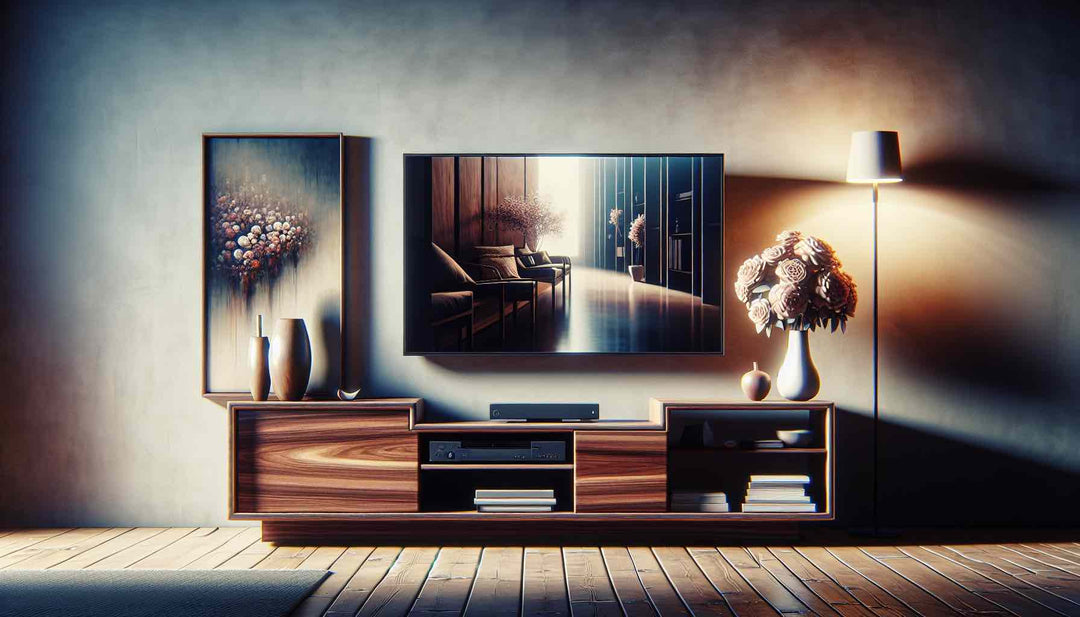Comparing Different Types of TV Stands: Find the Best Fit for Your Space

Looking for the perfect TV stand? This guide is all about comparing different types of TV stands, examining materials, designs, and features. By the end, you’ll know exactly which TV stand fits best in your home.
Key Takeaways
Different materials offer various benefits for TV stands. Wood is durable and timeless. MDF and particle board are eco-friendly and cost-effective. Metal and glass provide a modern touch.
Consider functional features. These include storage space, cable management, and adjustable shelves or mounts. They ensure your TV stand meets both aesthetic and practical needs.
Measuring your room for a TV is crucial. It helps you choose the right TV stand. It ensures stability, beauty, and a comfy view.
Understanding TV Stand Basics
TV stands are more than just a place to put your television. They offer a practical surface to place the TV. It's usually at seated eye level. This helps reduce glare and provide a comfortable view. Their design focuses on holding the TV’s weight. But, they also serve other purposes. They provide storage and enhance the room’s ambiance.
Moreover, TV stands are not just for housing TVs. You can repurpose them for other uses if you change your room setup. They are versatile furniture. The right TV stand can fit well in your space. It will improve its looks and define the room's function and mood.
Plus, with the right height, you can enjoy your favorite shows without straining your neck.
Types of TV Stands by Material
When it comes to TV stands, the material plays a crucial role in determining not just the look but also the durability and functionality. The most common materials in TV stands are wood, MDF (Medium-Density Fiberboard), and particle board. They also use metal and glass. Each material has its own advantages and considerations. So, it's important to choose one that fits your needs and style.
Wooden TV stands are known for their timeless appeal and sturdiness. They are a favorite for many homeowners. However, MDF and particle board stands are cheaper and more eco-friendly. But, they may not be as strong as wooden ones.
Metal and glass TV stands have sleek, modern designs. They cater to those looking for a contemporary touch in their living space. Let’s delve deeper into each material to understand their unique benefits.
Wooden TV Stands

Wooden TV stands are popular because of:
- Durability
- Timeless charm
- Sturdiness
- Longevity (less prone to scratches, cracks, or shattering compared to other materials)
- The wood has natural grain patterns and textures. They add a unique appeal. They provide rustic charm or contemporary elegance, depending on the design.
In addition to their aesthetic appeal, wooden TV stands have the following benefits:
- They are relatively easy to maintain. A simple cleaning with a damp cloth and occasional polishing can keep them looking fresh and new.
- They are adaptable to various interior decors.
- They have a robust construction, making them a versatile and reliable choice for any home.
MDF and Particle Board TV Stands
MDF and particle board TV stands are a budget-friendly option. They are also eco-friendly and an alternative to solid wood. Here’s how they are made:
- MDF is made from recycled solid wood products.
- The wood is broken down into fibers.
- The fibers are glued together.
- The glued fibers are formed into panels under high heat and pressure.
These stands are less dense and robust than wooden ones. But, they are cheaper and greener.
Metal and Glass TV Stands
For those seeking a modern and sleek design, metal and glass TV stands are an excellent choice. These stands are known for their contemporary lines that can add a modern touch to any living space. Metal frames provide strong support. They make these TV stands tough. The stands can hold a lot of weight. In addition, tempered glass shelves add strength. They are less likely to break than regular glass.
One of the significant advantages of metal and glass TV stands is their minimal upkeep. They are easy to clean with a wipe. They keep their appearance over time because they resist wear and tear. These stands are durable and look modern. They're popular in new homes. They're made of metal and glass.
Types of TV Stands by Design
TV stands come in a variety of designs, each catering to different décor themes and room layouts. You can find something for everyone. You can choose from from traditional TV cabinets to modern entertainment centers. There are also minimalist TV stands. They range from small units for tight spaces to large ones for big rooms. You can find a stand that fits your needs and style.
For instance, wooden TV stands have a classic look. Modern media consoles offer sleek lines and a contemporary appeal. Understanding the design options can help you choose a TV stand. It should fit your space and complement your décor.
Traditional TV Cabinets
Traditional TV cabinets are known for their:
- Ornate designs
- Durable construction
- Crafted from rich hardwoods or sleek metals
- Sense of sophistication that can enhance any room’s ambiance
- It has added features like built-in drawers or cabinets. They are for storing media accessories in a TV cabinet.
These cabinets are not only stylish but also practical. They are perfect for those who appreciate classic, timeless furniture pieces. They have a sturdy build and intricate designs. These can add an elegant touch to your living space. So, they are a worthwhile investment for any home.
Modern Entertainment Centers
Modern entertainment centers are ideal for those who spend a lot of time in their family room. These centers offer:
- Ample storage
- The features are built-in. They are tailored to modern needs. They include spaces for gaming consoles, media players, and other accessories.
- Designed to be the focal point of the room, providing both functionality and style.
They have sleek designs and useful storage. Modern entertainment centers can help you keep your living space organized and clutter-free. They are great for tech-savvy people. They need a full solution for their entertainment.
Minimalist TV Consoles
Minimalist TV consoles are all about simplicity and a clutter-free appearance. These TV console designs often have sleek lines and limited storage. They are ideal for keeping a clean and modern look in your living room. They typically offer some shelves and compartments. These hold key items, like a cable box, a vinyl player, or game consoles. This keeps your space organized without too much furniture.
If you prefer a minimalist aesthetic, these TV consoles are an excellent choice. They provide just enough storage for your essentials. They do this while keeping the focus on your TV and your room's décor.
Functional Features to Consider

When choosing a TV stand, you must consider the design and material. But, you must also consider the features that can improve your viewing. Features such as storage space, cable management, and adjustable shelves or mounts can greatly affect how usable your TV stand is. These features ensure that your entertainment area remains organized and free from clutter.
Well-designed cable holes allow for neat wire management. They keep unsightly cables out of sight and free from dust. The shelves and mounts are adjustable. They offer flexibility. They fit different sizes of electronic equipment and provide the best viewing angles.
Storage Space
Storage space is a critical feature to consider when choosing a TV stand. Dedicated storage reduces clutter. It also improves the usability of your living room. TV stands have lots of storage options. They have drawers, cabinets, or shelves. They let you store and organize items. These items include media players, gaming consoles, and accessories.
These storage solutions improve the room’s look by hiding essential items. They also make it easier to use your media devices. You may prefer open shelving for showing items. Or, you may like enclosed storage for a cleaner look. There are plenty of options to suit your needs.
Cable Management
Effective cable management is crucial for creating a tidy and organized entertainment area. Look for TV stands with cable ports. The ports let cords be drawn through the back of the stand. This makes for a neat and streamlined look. Cable raceways can provide full enclosure around wires, protecting them from dust and moisture.
By hiding your cables, you can keep a clean and clutter-free look in your living space. This not only enhances the overall aesthetic but also makes it easier to manage and access your electronic devices.
Adjustable Shelves and Mounts
The adjustable shelves and mounts in TV stands give flexibility. They can fit different sizes of electronic equipment, including wall units. These features allow you to customize the storage space to fit your needs. They ensure that your devices are organized and easy to access.
Some TV stands come with mounts that allow for varying TV sizes and optimal viewing angles. Choosing stands with adjustable height or mounts can give a more personalized experience. They make it easier to find the perfect setup for your living space.
Measuring for the Perfect Fit
Picking the right TV stand involves more than just choosing a style or material. It’s also about making sure it fits your TV and room well. Measuring the width and height of your TV is crucial to finding the appropriate size TV stand or console. Start by measuring the overall width from the far left edge to the far right edge, including the bezel.
Make sure to add a few extra inches on either side of the TV’s width for stability and aesthetic balance. Use these measurements. They will help you find the ideal TV stand size. The size should not only support your TV but also match your room’s layout and design.
Calculating TV Width and Height
You must calculate the width and height of your TV. This is key to ensure that your TV stand can properly support and balance it. To measure your TV, start by measuring the width. Measure it from the far left edge to the far right edge, including the bezel. This measurement helps determine the TV stand's minimum width. It prevents tipping and ensures stability.
Next, measure the height of the TV from the base to the top edge of the bezel. The manufacturer typically advertises the diagonal length of the screen. But, it's important to measure the true size, including the frame. Knowing these dimensions will help you choose a TV stand. It should fit your TV and match your living space's look.
Ensuring Proper Aspect Ratio
Ensuring that your TV stand matches the aspect ratio of your TV is crucial for a balanced and cohesive look. The aspect ratio is the proportion of your TV screen's width to its height. Choosing a TV stand that fits this aspect ratio helps keep visual harmony in your room. It stops your setup from looking awkward or top-heavy.
Room Layout Considerations
Your room's layout plays a big role. It determines where your TV stand should go. Ideally, the height of the TV stand should allow the center of the TV screen to be at or slightly below eye level when you’re seated. This ensures a comfortable viewing experience without straining your neck.
Additionally, consider the overall room layout and flexibility. Position your TV stand away from direct sunlight. Also, keep it away from heating and cooling vents. This will prevent glare and heat damage.
A TV stand width that’s slightly wider than the TV provides stability and a cohesive appearance. Considering these factors will help you create a balanced and beautiful entertainment area.
Enhancing Your Living Space with the Right TV Stand

The right TV stand can greatly improve your living space. It can do so by making it more useful and attractive. TV stands by design can greatly influence the overall décor and functionality of a room. A well-designed TV stand has lots of storage. It can match your living space's decor and style. This makes the space more organized and appealing to the eye.
When choosing a TV stand, consider the following factors:
- Design: Find a TV stand that matches your style. It should also complement your living space.
- Functionality: Make sure the TV stand is sturdy. It must support the weight and size of your TV. It should also hold any extra equipment you have.
- Budget: Set a realistic budget. Use it to find a TV stand that meets your needs. But, don't compromise on quality.
- Long-term value: Evaluate the TV stand's cost, quality, and benefits. It's a smart investment that will enhance your living space for years.
Summary
Choosing the right TV stand involves considering many factors. These include the material, design, features, and size. Wooden TV stands are timeless and durable. MDF and particle board stands are affordable and eco-friendly. Metal and glass stands bring a sleek, modern touch to any room. Understanding the different design styles is key. They include traditional cabinets, modern entertainment centers, and minimalist consoles. They can help you find a TV stand that suits your space and style.
Functional features improve the TV stand. They include storage space, cable management, and adjustable shelves or mounts. Measuring your TV and room layout ensures a perfect fit. It creates a balanced and attractive setup. Consider all these factors. You can choose a TV stand that supports your TV and complements your living space. It will make your space more organized and appealing.
Frequently Asked Questions
What to consider when buying a TV stand?
Consider the width, height, and available space of the TV. Use them to choose a TV stand. This will ensure a well-balanced setup. And make sure the television is at a comfortable viewing height.
How do I measure my TV for the right TV stand?
Measure the overall width and height of your TV, including the bezel, to ensure the right fit for a TV stand.
What are the benefits of wooden TV stands?
Wooden TV stands are durable. They have a classic look and match many styles. They are also low-maintenance. Upgrade your living room with one today!
Why is cable management important in a TV stand?
Cable management is important in a TV stand. It keeps the area tidy and organized. It ensures that unsightly cables are out of sight and free from dust.
How do I ensure my TV stand matches my TV's aspect ratio?
To ensure your TV stand matches your TV's aspect ratio, choose a stand that matches the TV's ratio. This will give a visually balanced look.
















